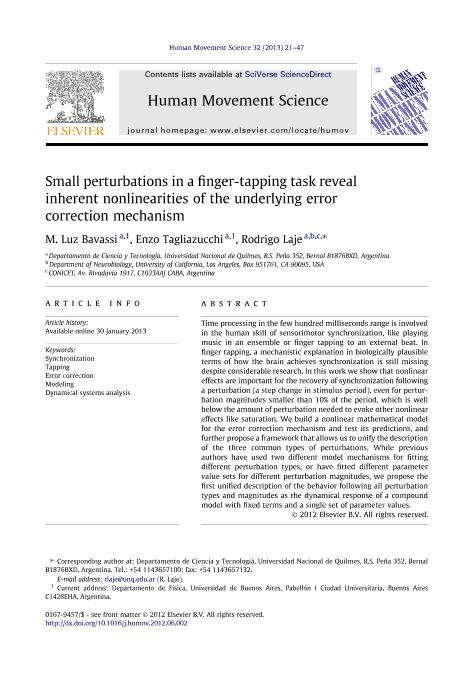Mostrar el registro sencillo del ítem
dc.contributor.author
Bavassi, Mariana Luz

dc.contributor.author
Tagliazucchi, Enzo Rodolfo
dc.contributor.author
Laje, Rodrigo

dc.date.available
2015-06-16T20:14:32Z
dc.date.issued
2013-02
dc.identifier.citation
Bavassi, Mariana Luz; Tagliazucchi, Enzo Rodolfo; Laje, Rodrigo; Small perturbations in a finger-tapping task reveal inherent nonlinearities of the underlying error correction mechanism; Elsevier Science Bv; Human Movement Science; 32; 1; 2-2013; 21-47
dc.identifier.issn
0167-9457
dc.identifier.uri
http://hdl.handle.net/11336/774
dc.description.abstract
Time estimation is critical for survival and control of a variety of behaviors, both in humans and other animals. Time processing in the few hundred milliseconds range, known as millisecond timing, is involved in motor control, speech generation and recognition, and sensorimotor synchronization like playing music or finger tapping to an external beat. In finger tapping, a mechanistic explanation in terms of neuronal activations of how the brain achieves average synchronization against inherent noise and perturbations in the stimulus sequence is still missing despite considerable research. In this work we show that nonlinear effects are important for the recovery of synchronization following a perturbation (a step change in stimulus period), even for perturbation magnitudes smaller than 10% of the period, which is well below the amount of perturbation needed to display other nonlinear effects like saturation. We build a mathematical model for the error correction mechanism and test its predictions, and further propose a framework that allows us to unify the description of the three common types of perturbations and all perturbation magnitudes with a single set of parameter values. While previous works have proposed that multiple mechanisms/strategies are used for correcting different perturbation conditions (based on fitting the model?s parameters separately to different perturbation types and sizes), our results suggest that the synchronization behavior can be interpreted as the outcome of a single mechanism/strategy, and call for a revision of the idea of multiple strategies.
dc.format
application/pdf
dc.language.iso
eng
dc.publisher
Elsevier Science Bv

dc.rights
info:eu-repo/semantics/openAccess
dc.rights.uri
https://creativecommons.org/licenses/by-nc-sa/2.5/ar/
dc.subject
Synchronization
dc.subject
Tapping
dc.subject
Modeling
dc.subject
Error Correction
dc.subject.classification
Otras Ciencias Naturales y Exactas

dc.subject.classification
Otras Ciencias Naturales y Exactas

dc.subject.classification
CIENCIAS NATURALES Y EXACTAS

dc.title
Small perturbations in a finger-tapping task reveal inherent nonlinearities of the underlying error correction mechanism
dc.type
info:eu-repo/semantics/article
dc.type
info:ar-repo/semantics/artículo
dc.type
info:eu-repo/semantics/publishedVersion
dc.date.updated
2016-03-30 10:35:44.97925-03
dc.journal.volume
32
dc.journal.number
1
dc.journal.pagination
21-47
dc.journal.pais
Países Bajos

dc.journal.ciudad
Amsterdam
dc.description.fil
Fil: Bavassi, Mariana Luz. Universidad Nacional de Quilmes. Departamento de Ciencia y Tecnologia; Argentina
dc.description.fil
Fil: Tagliazucchi, Enzo Rodolfo. Universidad Nacional de Quilmes. Departamento de Ciencia y Tecnologia; Argentina
dc.description.fil
Fil: Laje, Rodrigo. Universidad Nacional de Quilmes. Departamento de Ciencia y Tecnologia; Argentina. University Of California; Estados Unidos de América;
dc.journal.title
Human Movement Science

dc.relation.alternativeid
info:eu-repo/semantics/altIdentifier/doi/http://dx.doi.org/10.1016/j.humov.2012.06.002
Archivos asociados
